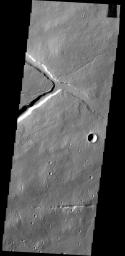
|
Which Came First?
- Click the image above for a larger view
- Full-Res JPEG (1429 x 2924) (367.8 kB)
- Full-Res TIFF (1429 x 2924) (4.2 MB)
Caption:
Towards the top of this VIS image is a "T" shaped depression and two sections of narrow channel. Fluids (like water -- or in this case most likely lava) flow downhill. If the depression formed first, the channels would have flowed towards the depression from both sides and then emptied into the depression, likely forming a delta deposit on both sides. If the channel formed first, it was a single channel and the fluid creating it stopped flowing before the depression was formed. Analysis of this image finds that the channel was created before the depression. This image is located on the northeast part of the Elysium Mons volcanic complex.
Orbit Number : 53550 Latitude : 26.5166 Longitude : 151.079 Instrument : VIS Captured : 2014-01-09 04:59
Background Info:
Please see the THEMIS Data Citation Note for details on crediting THEMIS images.
NASA's Jet Propulsion Laboratory manages the 2001 Mars Odyssey mission for NASA's Science Mission Directorate, Washington, D.C. The Thermal Emission Imaging System (THEMIS) was developed by Arizona State University, Tempe, in collaboration with Raytheon Santa Barbara Remote Sensing. The THEMIS investigation is led by Dr. Philip Christensen at Arizona State University. Lockheed Martin Astronautics, Denver, is the prime contractor for the Odyssey project, and developed and built the orbiter. Mission operations are conducted jointly from Lockheed Martin and from JPL, a division of the California Institute of Technology in Pasadena.
Cataloging Keywords:
| Name | Value | Additional Values |
|---|---|---|
| Target | Mars | |
| System | ||
| Target Type | Planet | |
| Mission | 2001 Mars Odyssey | |
| Instrument Host | Mars Odyssey | |
| Host Type | Orbiter | |
| Instrument | Thermal Emission Imaging System (THEMIS) | |
| Detector | ||
| Extra Keywords | Grayscale, Mountain, Thermal, Volcano, Water | |
| Acquisition Date | ||
| Release Date | 2014-02-26 | |
| Date in Caption | 2014-01-09 | |
| Image Credit | NASA/JPL-Caltech/ASU | |
| Source | photojournal.jpl.nasa.gov/catalog/PIA18026 | |
| Identifier | PIA18026 | |

